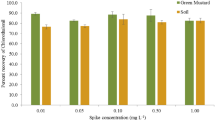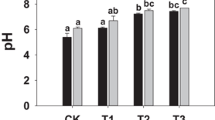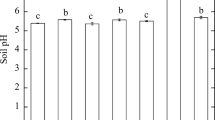Abstract
The loss of residual chlorpyrifos in soil and the amount translocated to Korean cabbage were investigated in this study. Field trials with Korean cabbage were carried out in two greenhouses located in Yongin (Field 1) and Gwangju (Field 2). Soil and Korean cabbage samples were collected on different days following the treatment of soil with chlorpyrifos at two different rates. The initial amounts of residue in soil were 1.15 and 3.58 mg/kg, and these decreased to 0.22 and 0.49 mg/kg at 36 days after treatment (DAT) in Field 1. These values were 20.9 and 59.3 mg/kg, decreasing to 3.03 and 5.24 mg/kg at 43 DAT in Field 2, respectively. In Field 1, the half-life of chlorpyrifos was approximately 15.0 and 10.2 days in soil treated with 0.12 and 0.24 g a.i./m2, respectively. In Field 2, the half-life of chlorpyrifos was approximately 27.7 and 9.6 days following application of 0.36 and 0.72 g a.i./m2, respectively. When compared with the initial concentration in soil, the absorption ratio of chlorpyrifos residue to Korean cabbage was 0.93–6.01 and 0.57–2.61%, respectively. Therefore, safe management guidelines for chlorpyrifos in soil used to cultivate Korean cabbage may be suggested as 3.3 mg/kg regarding the maximum residue limit of chlorpyrifos on Korean cabbage (0.2 mg/kg).




Similar content being viewed by others
References
Sasikala C, Jiwal S, Rout P, Ramya M (2012) Biodegradation of chlorpyrifos by bacterial consortium isolated from agriculture soil. World J Microbiol Biotechnol 28:1301–1308
Tomlin CDS (2015) A world compendium the pesticide manual, 15th edn. British Crop Protection Council, Alton
Oliver GR, Bolles HG, Shurdut BA (2000) Chlorpyrifos: probabilistic assessment of exposure and risk. Neurotoxicology 21:203–208
Johnson DE, Seidler FJ, Slotkin TA (1998) Early biochemical detection of delayed neurotoxicity resulting from developmental exposure to chloropyrifos. Brain Res Bull 45:143–147
Randhawa MA, Anjum FM, Ahmed A, Randhawa MS (2007) Field incurred chlorpyrifos and 3,5,6-trichloro-2-pyridinol residues in fresh and processed vegetables. Food Chem 103:1016–1023
EPA (2000) Chlorpyrifos revised risk assessment and agreement with registrant. Environmental Protection Agency, Washington, DC
KCPA (2016) Using guideline of crop protection agents. Korea Crop Protection Association, Samjung Inc., Seoul
Paterson S, Mackay D (1994) A model of organic chemical uptake by plants form soil and the atmosphere. Environ Sci Technol 28:2259–2266
Park BJ, Lee BM, Kim CS, Park KH, Park SW, Kwon H, Kim JH, Choi GH, Lim SJ (2013) Long-term monitoring of pesticide residues in arable soils in Korea. Korean J Pestic Sci 17:283–292
Kim HK, Choi DS, Kim SG (2013) Analysis of recent four years situation for pesticide residues in the GAP certified agricultural products analyzed by national agricultural cooperative federation. Korean J Pestic Sci 17:271–282
Hwang JI, Jeon SO, Lee SH, Lee SE, Hur JH, Kim KR, Kim JE (2014) Distribution patterns of organophosphorous insecticide chlorpyrifos absorbed from soil into cucumber. Korean J Pestic Sci 18:148–155
Li H, Sheng G, Chiou CT, Xu O (2005) Relationship of organic contaminant equilibrium sorption and kinetic uptake in plants. Environ Sci Technol 39:4864–4870
Lichtenstein EP (1959) Plant absorption of insecticides, absorption of some chlorinated hydrocarbon insecticide form soil into various crops. J Agric Food Chem 7:430–434
Lichtenstein EP (1960) Insecticide uptake from soils, insecticidal residues in various crops grown in soils treated with abnormal rates of aldrin and heptachlor. J Agric Food Chem 8:448–451
Lichtenstein EP, Myrdal GR, Schulz KR (1965) Insecticide uptake from soils, absorption of insecticidal residues from contaminated soils into five carrot varieties. J Agric Food Chem 13:126–131
Lim DH, Lim DS, Keum YS (2016) Translocation of polychlorinated biphenyls in carrot-soil systems. Korean J Pestic Sci 20:203–210
Chiou CT, Sheng G, Manes M (2001) A partition-limited model for the plant uptake of organic contaminants form soil and water. Environ Sci Technol 35:1437–1444
Briggs GG, Bromilow RH, Evans AA (1982) Relationship between lipophilicity and root uptake and translocation of nonionized chemicals by barley. Pestic Sci 13:495–504
Trapp S (1995) Plant contamination: modeling and simulation of organic chemical processes. Lewis Publishers, Boca Raton
Briggs GG, Bromilow RH, Evans AA, Williams M (1983) Relationship between lipophilicity and the distribution of nonionized chemicals in barley shoots following uptake by the roots. Pestic Sci 14:492–500
Hsu FC, Marxmiller RL, Yang AYS (1990) Study of root uptake and xylem translocation of cinmethylin and related compounds in detopped soybeans roots using a pressure chamber technique. Plant Physiol 93:1573–1578
Burken JG, Schnoor JL (1998) Predictive relationships for uptake or organic contaminants by hybrid poplar trees. Environ Sci Technol 32:3379–3385
Trapp S, McFarlane C, Matthies M (1994) Model for uptake of xenobiotics into plant: validation with bromacil experiment. Environ Toxicol Chem 13:413–422
Alkorta I, Garbisu C (2001) Phytoremediation of organic contaminants in soils. Bioresour Technol 79:273–276
Jeon SO, Hwang JI, Lee SH, Kim JE (2014) Uptake of boscalid and chlorfenapyr residues in soil into Korean cabbage. Korean J Pestic Sci 18:314–320
Lee EH, Hwang JI, Kim JE (2014) Patterns of uptake and removal by processing types of triazole fungicides in onion. Korean J Pestic Sci 19:248–254
Motoki Y, Iwafune T, Seike N, Otani T, Akiyama Y (2015) Relationship between plant uptake of pesticides and water-extractable residue in Japanese soils. J Pestic Sci 40:175–183
Collins C, Fryer M, Grosso A (2006) Plant uptake of nonionic organic chemicals. Environ Sci Technol 40:45–52
Dowdy DL, McKone TE (1997) Predicting the bioconcentration of organic chemicals from soil or air into plants using quantitative structure-activity relationships. Environ Toxicol Chem 16:2448–2456
Hwang KW, Bang WS, Jo HW, Moon JK (2015) Dissipation and removal of the etofenprox residue during processing in spring onion. J Agric Food Chem 63:6675–6680
McKone TE, Maddalena RL (2007) Plant uptake of organic pollutants from soil: bioconcentration estimates based on models and experiment. Environ Toxicol Chem 26:2494–2504
Lee JH, Park HW, Keum YS, Kwon CH, Lee YD, Kim JH (2008) Dissipation pattern of boscalid in cucumber under greenhouse condition. Korean J. Pestic Sci 12:67–73
Lee YD (2013) Practical guide for food code pesticide residue analysis (Extended ed), Osong, Korea
Juraske R, Vivas CSM, Velesquez AE, Santos GG, Moreno MBB, Gomez JD, Binder CR, Hellweg S, Dallos JAD (2011) Pesticide uptake in potatoes: model and field experiments. Environ Sci Technol 45:651–667
Acknowledgments
This work was financially supported by Cooperative Project “PJ010876012017” from the Rural Development Administration, Korea.
Author information
Authors and Affiliations
Corresponding author
Rights and permissions
About this article
Cite this article
Hwang, KW., Moon, JK. Translocation of chlorpyrifos residue from soil to Korean cabbage. Appl Biol Chem 61, 145–152 (2018). https://doi.org/10.1007/s13765-017-0341-5
Received:
Accepted:
Published:
Issue Date:
DOI: https://doi.org/10.1007/s13765-017-0341-5




